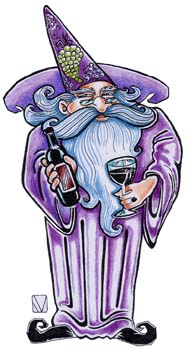Source:
http://winemakermag.com/mrwizard/245.html
<TABLE cellSpacing=3 cellPadding=0 width="85%" align=center><T>
<T>
<TR>
<TD vAlign=top width="85%">
What would happen if you added a vanilla bean to red wine in hopes of getting some vanilla flavors traditionally given off by oak barrels?</TD></TR>
<TR>
<TD colSpan=2></TD></TR>
<TR>
<TD colSpan=2></TD></TR>
<TR>
<TD vAlign=top colSpan=2>
Dear Wine Wizard,
I often hear about the vanilla flavors in red wines. I know that those flavors are derived over time from aging in oak barrels. I wanted to know what would happen if you added a vanilla bean or vanilla extract to a red wine?
R. Circe
East Lyme, Connecticut
The Wine Wizard replies: It’s illegal for commercial winemakers to add anything non-Vitis vinifera to their table wine and still have it be labeled as such. However, I’m sure that many an enterprising home winemaker has done what you suggest. Indeed, since vanilla (natural or artificial) is a lovely flavor and aromatic component of many foods and beverages, it makes perfect sense to consider it as a wine additive.
A compound called vanillin is responsible for the vanilla-like aroma that is often associated with oak aging, especially of Bordeaux varietals (Cabernet Sauvignon, Merlot and Cabernet Franc). Vanillin is one of the six-membered benzene ring structures (remember your high school chemistry course?).
Commercial vanilla extract is high in vanillin, or compounds that smell remarkably like it, and I could see a small amount being an interesting component in some styles of homemade wine.
The main challenge to using any aroma or
flavor-boosting compound is how to do it in such a way that the results are pleasing to the winemaker. My first piece of advice is to be conservative. Commercially-available vanilla extracts are potent liquids and, as any cook knows, a little goes a long way. As when adding anything that could potentially make your wine objectionable if you over-did it, I recommend conducting the additions on a small scale first.
This technique, known in the industry as bench testing, is a down-sized way to take a look at how a small amount of an additive behaves in a small amount of wine. “Small” will depend upon the size of your lots and the scale of measuring equipment you have to work with. Since most home winemakers don’t have micro-pipettes — pipettes that can measure out microliters, as opposed to milliliters, of a liquid — I suggest trying a drop of something in, say, 200 mL of the wine you’re interested in adding it to. Give that a sniff and a taste and, if you like the addition at that rate, you can feel comfortable applying it to the rest of your batch of wine.
It’s always better to take the test drive a little further just to be sure, however. Seal that 200 mL sample of wine in an airtight, full (topped) container like a baby food jar overnight. Give it the sniff and taste test the next day and see if you’re still happy with the results. Don’t forget to check the clarity of the wine sample as well. Sometimes adding anything — whether it’s a fining agent, oak chips or a flavor extract — can cause imbalances and in-stabilities in wine that will result in a haze or a precipitate. If this is the case, and you still want to proceed with the addition, keep in mind that you will have to rack, fine or filter in order to remove the instability before you bottle your wine.
If you want to experiment with real vanilla beans, an easy way to get their natural aromas and flavors into your wine is to make a homemade vanilla extract. Fill a small, airtight glass container (such as baby food jars or old spice jars) with a neutral ethyl alcohol (such as rum or vodka). Add as many vanilla beans as you can either fit in the jar or afford. Set the jar in a warm or sunny spot, agitate every other day for at least two weeks and soon you’ll have your own homemade vanilla extract! You can use it dropwise in your bench trials, for mixing cocktails, making beverages or just baking cookies. Don’t forget that this trick works great for other dry spices and flowers like cinnamon sticks, cloves, rose petals, lavender flowers and the like. Just be conservative in adding and try only a small amount of extract in a little bit of your wine first.
Vanilla beans are extrememly pungent. Dropping a vanilla bean, or even part of one, into a carboy would probably soon impart too much vanilla aroma and flavor, and that of the wine would be lost very quickly. It’s always dangerous to risk an entire lot, or even an entire carboy, on an unmeasured addition like that. Similarly, as grapes and barrels vary, so do vanilla beans. It’s impossible to predict how much flavor or aroma one bean might impart over another. This is why I recommend creating tinctures, with which one can conduct bench trials.
Keep in mind that aging in oak barrels not only imparts the vanilla flavors, but also contributes to the overall wine structure and character through microoxygenation. Oak tannins, lig-nins, and other carbohydrates are also extracted while a wine ages in oak barrels. You won’t achieve that spectrum of flavors simply by adding vanilla extract to your wine. The delicate interaction of the wine with the oak, lees and air all play a part in how a wine turns out.
</TD></TR></T></T></TABLE>











